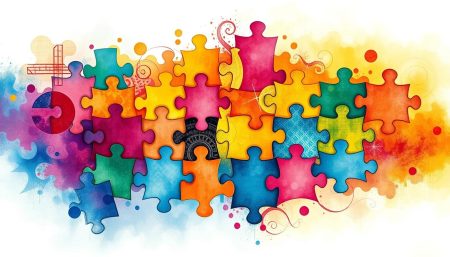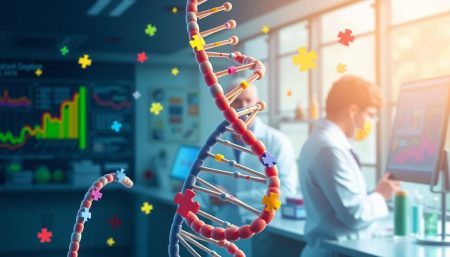Understanding the differences between ADHD (Attention Deficit Hyperactivity Disorder) and Autism Spectrum Disorder (ASD) is key. Both affect development and can share symptoms. Yet, they have distinct features that set them apart.
Parents, teachers, and doctors struggle to see the differences in behavior and communication. These differences are what make each condition unique. Studying these differences helps us understand the challenges faced by those with ADHD or ASD.
This guide will help us understand the ADHD and autism differences. We’ll look at how each disorder shows up and what it means for support and therapy. We’ll explore the defining traits and the contrasts between ADHD vs ASD.
Understanding Neurodevelopmental Disorders
Neurodevelopmental disorders are conditions that show up early in a child’s life. They can greatly affect their behavior, social skills, learning, and emotional health. This part explores these disorders, focusing on their impact on early development and the need for early diagnosis.
What Are Neurodevelopmental Disorders?
These disorders cause significant developmental delays in kids. They can lead to problems with movement, learning, speaking, and communication. ADHD and Autism Spectrum Disorder are two common ones, each with its own challenges and treatment needs.
The Impact on Early Development
Diagnosing ADHD and Autism early can greatly help a child. It lets them better handle school and social life. Early signs should be noticed by parents, teachers, and doctors to start helpful treatments.
Early help is key because these disorders can deeply affect a child’s life. They can impact thinking, social skills, and feelings.
Helping kids with neurodevelopmental disorders is more than just treating them. It’s also about making supportive environments. These places should be able to meet the special needs of these children. By supporting them, we can improve their therapy and education.
Characteristics of ADHD Spectrum
Understanding the ADHD spectrum is key to spotting the wide range of ADHD symptoms. It helps in boosting cognitive functioning in ADHD. This disorder shows up in many ways, affecting behavior and learning.
ADHD isn’t the same for everyone. It’s a spectrum where symptoms differ greatly from person to person. We’ll look at the main traits of the ADHD spectrum. This highlights the need for personalized ways to manage it.
- Inattention: People might find it hard to focus and forget things in everyday life.
- Hyperactivity: This means too much movement that doesn’t fit the situation, like fidgeting or trouble sitting.
- Impulsivity: Acting without thinking, which can sometimes cause harm.
These symptoms greatly affect cognitive functioning in ADHD. They change how people handle information and tasks.
| Age Group | Common ADHD Symptoms | Cognitive Impact |
|---|---|---|
| Children (3-10 years) | Difficulty following instructions, unable to focus on schoolwork | Learning challenges, slower cognitive development |
| Adolescents (11-17 years) | Risk-taking behaviors, inconsistency in school performance | Poor executive functioning, issues with time management |
| Adults (18+ years) | Problems with time management, prioritizing tasks | Impaired occupational performance, strained social relationships |
The table shows how ADHD symptoms and their effects on cognitive functioning change with age. Knowing these patterns is vital for creating effective treatments for each person in the ADHD spectrum.
Autism Spectrum Disorder Symptoms
Autism Spectrum Disorder (ASD) is a complex condition that affects people differently. It brings challenges in communication challenges in ASD and behavioral patterns in ASD. Knowing these challenges helps in providing the right support and help.
Communication Challenges in ASD
People with ASD often struggle with talking and understanding body language. They might speak late or have trouble with gestures. They might also repeat words or take words too literally.
Studies show that improving communication for those with ASD needs a special approach. For more details, check out this resource on how autism is different from other mental health issues.
Behavioral Patterns and Repetitiveness
ASD often shows through repetitive actions or intense interests. These behaviors help them feel safe or manage uncertainty. But, sticking to routines too much can cause stress if they change.
Early help that uses behavioral strategies can make a big difference. It helps them adapt better and manage their Autism Spectrum Disorder symptoms.
Understanding and addressing ASD’s core symptoms is key to managing it. Family support and structured behavioral interventions are also vital. For more on autism and mental health, see this essential guide.
ADHD vs Autism Spectrum Disorder
It’s important to understand the difference between ADHD vs Autism Spectrum Disorder. They share some traits but also have key differences. This section will explore both the ADHD and Autism similarities and the ADHD and Autism differences. This will help us better grasp these complex conditions.
ADHD and Autism Spectrum Disorder both have social and attention challenges. Yet, they differ in symptoms and treatment. By looking at their unique traits, we can gain a deeper understanding of each condition.
- Both disorders show signs of inattentiveness and hyperactivity.
- People with either condition may struggle in social interactions and communication.
- ADHD often includes impulsivity, while Autism is linked to repetitive behaviors or interests.
The table below compares key clinical features:
| Feature | ADHD | Autism Spectrum Disorder |
|---|---|---|
| Focus Issues | Often can’t focus for long | Focuses intensely on specific interests |
| Social Interaction | Has trouble staying patient in social settings | Struggles to understand social cues and norms |
| Communication | May interrupt or speak out of turn | May have delayed speech and trouble in conversations |
| Behavioral Patterns | Acts impulsively, without thinking | Shows repetitive behavior, intense focus on routines |
In summary, ADHD and Autism similarities include challenges in social and cognitive areas. But, the ADHD and Autism differences are significant. This means we need different approaches for diagnosis and treatment. Knowing these differences helps us diagnose accurately and treat effectively.
Evaluating ADHD and Autism Similarities
ADHD and Autism Spectrum Disorder (ASD) are different but share some traits. These similarities make it hard to diagnose and understand each condition. They often overlap in social interaction, communication, and behavior.
Social Interaction and Communication
Both ADHD and Autism face challenges in social interaction and communication. People with these conditions might struggle to connect with others. They may find it hard to understand social cues, keep up in conversations, and see things from other people’s viewpoints.
They might also prefer routine in how they communicate. Social situations can feel overwhelming. And, they might have trouble showing emotions in the right way.
This similarity means we need special help to improve their social and communication skills. This help is important for both ADHD and Autism.
Overlap in Behavioral Traits
ADHD and Autism also share some behavioral traits. For example, impulsivity and repetitive actions are common in both. Impulsivity in ADHD means acting without thinking. In Autism, it’s about needing routine and predictability.
| Behavioral Trait | Manifestation in ADHD | Manifestation in Autism |
|---|---|---|
| Impulsivity | Hasty decisions, lack of forethought | May appear in social interactions or communication mishaps |
| Repetitive Behaviors | Less common, might involve routines in daily tasks | Common, often centered around specific interests or routines |
| Sensitivity to Change | May struggle with unexpected changes, prefers known sequences | Intense stress and anxiety when routines are disrupted |
This table shows how similar behaviors can look different in ADHD and Autism. It highlights the need for careful understanding and tailored strategies for each person.
The Diagnostic Journey: Diagnosis of ADHD and Autism
Diagnosing ADHD and autism is a detailed process. It involves many healthcare professionals working together. They help understand the symptoms and behaviors of these disorders. They also use special tools for assessment.
Healthcare Professional Involvement
Getting a diagnosis for ADHD and autism needs a team effort. Pediatricians, child psychologists, and neuropsychologists are part of this team. They gather information through observations, interviews with parents, and looking at the child’s development history.
Because these disorders are complex, they need time to assess. This is done over several sessions. It helps rule out other conditions and get a precise diagnosis.
Assessment Tools and Criteria
Professionals use special tools to diagnose ADHD and autism. These tools check different areas like thinking, behavior, social skills, and emotions.
| Assessment Tool | Utility in Autism | Utility in ADHD |
|---|---|---|
| AQ (Autism Spectrum Quotient) | Measures the degree of autistic traits | Less relevant |
| Conners’ Rating Scales | Used for comparative analysis | Assesses ADHD symptom severity |
| ADOS (Autism Diagnostic Observation Schedule) | Critical for ASD diagnosis | Not applicable |
These tools help tell ADHD symptoms apart from autism’s. They guide healthcare professionals to the best treatment plans for each child.
Exploring ADHD and Autism Differences
It’s key to know the differences between ADHD and Autism Spectrum Disorder for the right diagnosis and treatment. This part looks at the main differences, focusing on cognitive functioning and social interactions. These differences guide how doctors treat and support people with these conditions.
ADHD and Autism differences show up in how symptoms appear, mainly in thinking tasks and social skills. ADHD makes it hard to stay focused and control impulses. Autism, on the other hand, makes social talking and repeating actions tough.
When we talk about thinking, ADHD and Autism show different struggles. People with Autism might really focus on certain things and remember well, but struggle with abstract thinking. Those with ADHD might find it hard to concentrate and get distracted easily, affecting their thinking in different ways.
How people interact socially also varies between ADHD and Autism. ADHD folks might talk a lot and interrupt, not understanding social cues well. Autism makes social cues hard to get, leading to seeming less interested in socializing because of trouble with emotional and communicative signs.
Also, the need for specific treatments for each condition is clear. Here’s a detailed comparison:
| Aspect | ADHD | Autism |
|---|---|---|
| Cognitive Functioning | Problems with attention, tendency towards impulsivity | Challenges with executive functioning, detailed focused cognition |
| Social Interactions | Excessively social, difficulty maintaining social etiquette | Difficulty understanding social cues, may prefer solitude |
Cognitive Functioning in ADHD vs ASD
Looking into cognitive functioning in ADHD vs ASD shows big differences. These differences are seen in focused attention and executive function. We will explore how people with these conditions handle information and daily tasks.
Focused Attention vs. Broad Attention
People with ADHD have trouble with focused attention. They find it hard to stay on one task without getting distracted. On the other hand, those with ASD might have broad attention. This means they can take in lots of details at once, which can sometimes feel overwhelming.
Executive Function and Coping Strategies
When it comes to executive function, ADHD often makes planning and organizing hard. This is different from ASD, where some executive functions are strong, but flexibility is a challenge.
To better understand these differences, let’s look at a table. It compares executive function and coping strategies for ADHD and ASD:
| Function | ADHD | ASD |
|---|---|---|
| Attention Regulation | Easily distracted, struggles with sustained effort | Over-focus on particular details, challenges in shifting attention |
| Goal Setting | Difficulty in setting and following through with goals | May set rigid, unchanging goals |
| Flexibility | Problems with adapting to change, prefers routines | Significant challenges with transitions, high need for predictability |
| Problem Solving | Impulsive decisions, lack of strategy | Difficulty with abstract concepts, prefers concrete thinking |
| Coping Strategies | Relies heavily on external reminders, benefits from hands-on support | Utilizes detailed schedules and visual aids to understand and manage tasks |
Behavioral and Social Interactions
We explore the complex worlds of Autism Spectrum Disorder (ASD) and Attention-Deficit/Hyperactivity Disorder (ADHD). We focus on their effects on behavioral and social interactions. Both disorders make it hard to navigate social cues and manage impulsivity. But, understanding these challenges can help a lot in interactions and therapy.
Navigating Social Cues in ASD and ADHD
People with ASD struggle with navigating social cues. They often find it hard to read body language, tone of voice, and facial expressions. Those with ADHD might get these cues but act impulsively and hyperactively. Training and therapy can teach them how to communicate better.
Understanding and Managing Impulsivity
Managing impulsivity in ADHD needs behavioral help. This includes teaching self-control and thinking before acting. Techniques like routines, reminders, and positive reinforcement are helpful.
Impulsivity is less of an issue in ASD, but managing sudden behaviors is important. This can help ASD individuals control their responses in social situations.
For more on how these behaviors affect mental health and how to manage them, check out this resource.
ASD and ADHD need special strategies for behavioral and social interactions. With the right therapies and interventions, caregivers and healthcare professionals can help a lot. These methods improve daily life and overall well-being for those with these disorders.
Co-occurrence of ADHD and Autism Spectrum Disorders
ADHD and Autism Spectrum Disorders often happen together, making diagnosis and treatment harder. People with both conditions face unique challenges. This mix of symptoms can make it tough for doctors to treat each disorder properly.
It’s important to understand this dual diagnosis to help these individuals. Studies show that those with both ADHD and Autism may have more severe symptoms. This includes bigger problems with social skills and managing tasks.

| Aspect | Impact on ADHD | Impact on Autism |
|---|---|---|
| Social Interactions | May increase impulsiveness and difficulty maintaining friendships | Enhances challenges in social reciprocity and understanding non-verbal cues |
| Attention Span | Further complicates sustained attention and task completion | Can exacerbate focus on specific interests, reducing responsiveness to external changes |
| Behavioral Overlaps | Increased hyperactivity and potentially oppositional behaviors | Greater likelihood of repetitive behaviors and resistance to change |
Managing ADHD and Autism together needs a detailed plan. It must tackle both disorders’ unique and shared symptoms. Doctors must carefully choose treatments to avoid making symptoms worse.
This careful balance is essential for improving life quality. It helps individuals function better and live happier lives.
Understanding and tackling ADHD and Autism together is critical. It’s not just for doctors but also for schools and social groups. They need to be ready to support people with these complex conditions.
Parental Guidance and Support Strategies
Supporting kids with ADHD and Autism Spectrum Disorder (ASD) needs a lot of effort from parents. This part talks about ways to help. It focuses on creating a structured space and using positive reinforcement. This helps parents guide their kids towards growth.
Creating a Structured Environment
For kids with ADHD or ASD, a structured space is key. It means having set schedules and routines. This reduces stress and makes things clearer.
Parents playing a big role in keeping things structured helps kids. It makes them better at following rules and learning.
Positive Reinforcement and Behavioral Techniques
Positive reinforcement is a big help. It uses rewards or praise to encourage good behavior. This method works well when done regularly.
Parents can use it to praise kids for good actions. This is very helpful for kids with ADHD and ASD.
- Increase in Self-esteem through regular positive feedback
- Enhanced cooperation and motivation
- Improved behavior and social interactions
Using these methods takes patience and flexibility. But, they can really help kids do better in school and with friends.
Educational Challenges and Adaptations
Students with neurodevelopmental disorders face big challenges in school. Those with ADHD and ASD find it hard to learn and join in. We need to make schools better for them.
Good changes in school are more than just making it easy to get in. They help students with ADHD and ASD do well. These changes might include special teaching methods or support services.
- Personalized learning plans to cater to individual strengths and weaknesses
- Visual aids and technology-integrated learning tools to enhance comprehension
- Structured routines to provide a predictable learning environment
- Training for educators on the nuances of neurodevelopmental disorders in education
These educational adaptations are key to helping students with ADHD and ASD. They make school better for everyone. By changing how we teach, we can help all students succeed.
Creating a better school for students with neurodevelopmental disorders is important. It takes hard work from schools to make these changes work.
ADHD and Autism Treatment Approaches
Managing ADHD and autism well often means using many different methods. This includes both medical treatments and therapy. Knowing about each option helps caregivers and doctors choose the best plan for each person.
Pharmacological Interventions
Medicines play a big role in treating ADHD and autism. They help with symptoms like too much activity, not paying attention, and acting without thinking. For autism, they help with being too rigid and feeling anxious. Doctors pick the right medicine based on the person’s symptoms and health.
Therapeutic Services and Behavioral Therapy
Therapy covers many areas, like talking better, getting along with others, and acting right. Behavioral therapy is key in treating ADHD and autism. It helps change bad behaviors and teach new ones. This makes it easier for people to do well in school and at home.
Behavioral therapy is adjusted often to meet changing needs. The goal is to lessen bad behaviors and help people be more independent and social.
| Treatment Type | Focus | Common Interventions |
|---|---|---|
| Pharmacological | Symptom Management | Stimulants, Non-stimulants, Antidepressants |
| Behavioral Therapy | Skill Development | Cognitive Behavioral Therapy, Social Skills Training, Applied Behavior Analysis |
| Therapeutic Services | Overall Improvement | Occupational Therapy, Speech Therapy |
Medicines and behavioral therapy are both important for treating ADHD and autism. By making these plans fit each person’s needs, we can really improve their life and how well they function.
Advocating for Children with Neurodevelopmental Disorders
Advocacy is key in improving the lives of kids with ADHD and Autism Spectrum Disorder (ASD). By advocating for children, we create a community that values and acts on their needs. It’s about spreading awareness and the importance of early help.
Building Awareness and Understanding
Good advocacy starts with teaching others about neurodevelopmental disorders. This includes educators, healthcare workers, and the public. Awareness campaigns help us understand these conditions better.
This knowledge helps us spot symptoms early and meet their needs. It also helps kids fit in better at school and in society.
The Importance of Early Intervention
Early help is vital for kids with neurodevelopmental disorders. It helps them grow and become independent. Early diagnosis and support can greatly improve their development.
Advocacy groups play a big role in this. They keep the focus on these children and help get them the help they need.
The Role of Technology in Managing Symptoms
In today’s world, technology is key in managing symptoms with technology for those with ADHD and Autism Spectrum Disorders. Tools like apps and software are helping a lot. They offer support that fits each person’s needs, making daily life easier and helping them stick to their treatment plans.
Technology is a big help for those with ADHD. It provides structure and helps with focusing. Apps with reminders and organizers can make a big difference. For autism, apps that help with communication and social skills are showing great results. They use sounds and pictures to help with language and understanding social cues.
Teachers and parents are using technology to help kids with ADHD and Autism. It’s a great tool to use along with traditional teaching methods. It also helps track progress and adjust learning plans. This shows how important managing symptoms with technology is in today’s care for ADHD and Autism Spectrum Disorders.
FAQ
Q: What are the key differences between ADHD and Autism Spectrum Disorder?
A: ADHD and Autism Spectrum Disorder are both neurodevelopmental disorders. ADHD is linked to inattention, hyperactivity, and impulsiveness. Autism is about social skills, communication, and repetitive behaviors. Each has its own diagnostic criteria and treatment methods.
Q: What are neurodevelopmental disorders?
A: Neurodevelopmental disorders affect learning, behavior, emotions, and social skills early in life. They include ADHD, ASD, learning disabilities, and intellectual disability.
Q: How does ADHD present itself, and what are its main symptoms?
A: ADHD symptoms include inattention, distractibility, hyperactivity, and impulsiveness. It has three subtypes: inattentive, hyperactive-impulsive, and combined. Symptoms vary by person and age.
Q: What are common communication challenges and behaviors in Autism Spectrum Disorder?
A: People with ASD face challenges in verbal and nonverbal communication. They might struggle to keep conversations and understand social cues. They often have repetitive actions and strict routines.
Q: In what ways are ADHD and Autism Spectrum Disorder similar?
A: ADHD and ASD share similarities that can make diagnosis tricky. Both can affect social interaction and communication. They also share traits like impulsivity and inattention.
Q: What is involved in the diagnosis of ADHD and Autism?
A: Diagnosing ADHD and Autism involves a detailed evaluation by healthcare professionals. This includes a developmental history, observation, and standardized tests. Behavior checklists, rating scales, and interviews are also used.
Q: What are the primary differences between ADHD and Autism?
A: ADHD is mainly about attention and hyperactivity. Autism is about social communication and repetitive behaviors. Each disorder has unique challenges and treatment needs.
Q: How do cognitive functioning and coping strategies differ in ADHD versus ASD?
A: ADHD affects attention and impulsivity due to executive function challenges. ASD individuals focus intensely on specific interests and use unique strategies for social and sensory issues.
Q: Can an individual have both ADHD and Autism Spectrum Disorder?
A: Yes, it’s possible to have both ADHD and Autism. This can make diagnosis and treatment more complex. Each condition adds its own layer of complexity.
Q: What strategies can parents utilize to support children with ADHD and Autism?
A: Parents can help by creating a structured environment and using positive reinforcement. Tailored interventions are key for their development and well-being.
Q: What adjustments are necessary for children with neurodevelopmental disorders in the educational setting?
A: Schools need to make accommodations for children with neurodevelopmental disorders. This includes individualized education plans, specialized teaching, and assistive technologies.
Q: What treatment approaches are employed for ADHD and Autism?
A: ADHD treatment often includes medication and behavioral therapies. Autism treatment may involve behavioral interventions, speech and occupational therapy, and medication for specific symptoms. Both require a personalized approach.
Q: What role does advocacy play for children with neurodevelopmental disorders?
A: Advocacy raises awareness and improves understanding. It ensures access to services and support. It empowers parents, educators, and health professionals to help children with neurodevelopmental disorders.
Q: How is technology used to manage symptoms of ADHD and Autism Spectrum Disorders?
A: Technology helps manage ADHD and ASD symptoms. It aids in organization, task management, and communication. It also offers therapeutic tools for parents and educators.


















